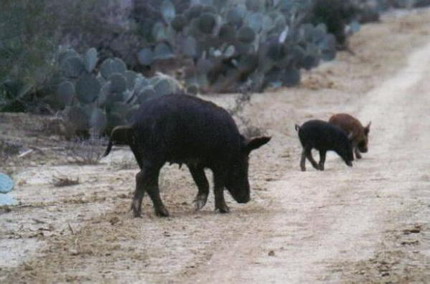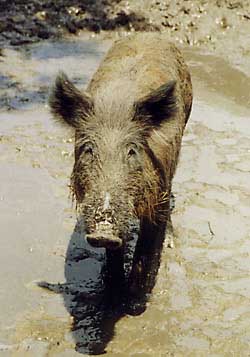Feral pigs are very intelligent animals and readily adapt to changing conditions. These wild pigs may modify their response to humans fairly rapidly if it benefits their survival. Wild boar (introduced from Europe) have a greater capacity to invade colder and more mountainous terrain than do other feral pigs. Feral hogs feed during daylight hours or at night, but if hunting pressure becomes too great during the day, they will remain in heavy cover at that time and feed at night. In periods of hot weather, wild pigs remain in the shade in wallows during the day and feed at night. Continue reading Feral Hog Biology and Behavior
Tag: Feral Hogs
Trapping Feral Hogs
Trapping, especially where feral hog densities are high, is probably the most effective control method. However, traps may not be effective during fall and winter when acorns or other preferred natural foods are available. Hogs seem to prefer acorns over grain and other baits, probably due to the larger percentage of fat found in acorns. Leg snares and hunting may be more productive control methods during fall and winter, but usually require considerably more effort and should not be considered a long-term control stragegy. Stationary corral-type traps and box traps have been used with success, and will help to control numbers, but will not eliminate a hog population.
The corral or stationary trap is permanent and should be constructed in locations where large populations of hogs are evident and where more than one hog can be trapped at a time. It is recommended that the trap be built out of steel fence posts and 2 x 4-inch welded 12-gauge wire fencing. A gate frame can be made from 2 x 4-inch boards. Make doors from 3/4-inch plywood and mount them so that they open inward and close automatically with screen door springs. Heavier material may be used for the gate and frame in areas where exceptionally large hogs are to be trapped. Also, more steel fence posts may be needed to reinforce the wire fencing. The wire fencing should be put on the ground as well as at the top of the trap to prevent hogs from going under the sides or over the top. Fasten the sides to the top and bottom. Continue reading Trapping Feral Hogs
Economics of Feral Hog Damage and Control
In most areas it is unlikely that feral pigs can be exterminated. It is theoretically possible, but the cost to totally eliminate feral hogs in usually prohibitive. In addition, even though it is theoretically possible to control wild hogs, I still don’t think it is possible because of the areas they inhabit. With this in mind, landowners must generally accept the fact that they will always have some wild pigs, and should therefore plan for a long-term control program.
Feral hog damage can be extensive and costly if not controlled. Control for disease suppression is extremely expensive because many hogs would need to be eliminated, the density greatly reduced to slow (much less stop) the transfer of disease between hog populations.

Crop depredations may cease after one or two hogs are shot or trapped, or intermittent hunting pressure is put on them. They simply move to new areas. If hog depredations are heavy enough to require a reduction in the overall population, then a program can be very costly, depending on the size of the area involved. Keep in mind that wild hogs cannot be eliminated by shooting or trapping, both together or alone, but these actions can help keep hogs numbers under control — or on your neighbors property!
